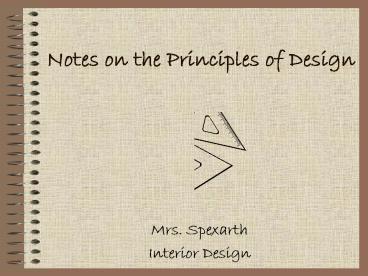Notes on the Principles of Design - PowerPoint PPT Presentation
1 / 29
Title:
Notes on the Principles of Design
Description:
The principles of design are the 'rules' or guidelines that one should follow ... Variety: is the absence of monotony or sameness, brings interest and diversity. ... – PowerPoint PPT presentation
Number of Views:112
Avg rating:3.0/5.0
Title: Notes on the Principles of Design
1
Notes on the Principles of Design
- Mrs. Spexarth
- Interior Design
2
Principles of Design the theory or governing
ideas that determine successful design.concepts
that are important for great architecture, art,
furnishings, fashion etc.
- The principles of design are the "rules" or
guidelines that one should follow when using the
elements of design.
3
- Scale overall size, such as the largeness or
smallness of a room, object, or pattern. - -Deals with the actual and relative size and
visual weight. Words used to describe scale are
small, light, medium, large, heavy.
4
Example of Scale
5
Example of Scale
6
Proportion size relationship or ratio of parts
to whole, such as the size of a chair in relation
to the size of its arms. -very closely related
to scale
7
Example of Proportion
8
Example of Proportion
9
- Balance equilibrium achieved by arranging
components symmetrically, asymmetrically, or
radially. - -symmetrical balance creates a mirror image by
the placement of items that are exactly the same
on both sides of a central point.
10
Example of Symmetrical Balance
11
Symmetrical Balance
12
- -asymmetrical balance can be accomplished two
ways. - 1. Dissimilar objects can be placed at varying
distances from the center point. - 2. Objects of dissimilar visual weight or form
may be balanced at equal distance from an
imaginary central dividing line.
13
Example of Asymmetrical Balance
14
Example of Asymmetrical Balance
15
Example of Asymmetrical Balance
16
- -radial balance the state of equilibrium that is
based on the circle. - Can be seen as chairs surrounding a table, the
grain of a dining table where the veneer is
laid in sections that meet in the center.
17
Example of Radial Balance
18
- Rhythm flow of elements, usually organized
according to one of five schemes. - 1. Repetition and alternation
- 2. Progression or gradation
- 3. Transition
- 4. Opposition or contrast
- 5. Radiation
19
Example of Rhythm
20
Example of Rhythm
21
Example of Rhythm
22
Example of Rhythm
23
- Emphasis enhancement that produces a point of
interest or focal point in a design. - -examples include a fireplace, a large window,
a dramatic piece of art, an impressive piece or
grouping of furniture.
24
Example of Emphasis
25
Example of Emphasis
26
- Harmony compatibility of elements to create a
pleasing whole, achieved through unity and
variety. - -Unity suggests a oneness and uniformity or
and identity that suggests a master plan - -Variety is the absence of monotony or
sameness, brings interest and diversity.
27
Example of Unity
28
Example of Unity
29
Example of Variety































